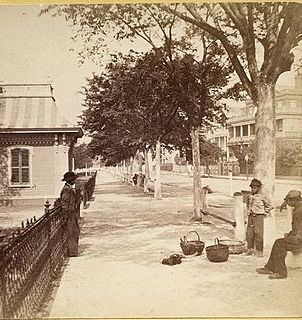
Fort Sumter is a sea fort built on an artificial island protecting Charleston, South Carolina, from naval invasion. Its origin dates to the War of 1812 when the British invaded Washington by sea. It was still incomplete in 1861 when the Battle of Fort Sumter began the American Civil War. It was severely damaged during the war, left in ruins, and although there was some rebuilding, the Fort as conceived was never completed.

Moultrie County is a county in the U.S. state of Illinois. According to the 2010 United States Census, its population was 14,846. Its county seat is Sullivan. The name is pronounced as in "mole tree", unlike the pronunciation of its namesake, the South Carolinian Revolutionary War hero William Moultrie.

Sullivan's Island is a town and island in Charleston County, South Carolina, United States, at the entrance to Charleston Harbor, with a population of 1,791 at the 2010 census. The town is part of the Charleston metropolitan area, and is considered a very affluent suburb of Charleston.

William Moultrie was a South Carolina planter and politician who became a general in the American Revolutionary War. As colonel leading a state militia, in 1776 he prevented the British from taking Charleston, and Fort Moultrie was named in his honor.

The Battle of Fort Sumter was the bombardment of Fort Sumter near Charleston, South Carolina by the South Carolina militia, and the return gunfire and subsequent surrender by the United States Army, that started the American Civil War.

The flag of South Carolina is a symbol of the U.S. state of South Carolina consisting of a blue field with a white palmetto tree and white crescent. Roots of this design have existed in some form since 1775, being based on one of the first Revolutionary War flags.

Fort Moultrie is a series of fortifications on Sullivan's Island, South Carolina, built to protect the city of Charleston, South Carolina. The first fort, formerly named Fort Sullivan, built of palmetto logs, inspired the flag and nickname of South Carolina, as "The Palmetto State". The fort was renamed for the U.S. patriot commander in the Battle of Sullivan's Island, General William Moultrie. During British occupation, in 1780–1782, the fort was known as Fort Arbuthnot.

William Jasper was a noted American soldier in the Revolutionary War. He was a sergeant in the 2nd South Carolina Regiment.

Fort Sumter and Fort Moultrie National Historical Park is a United States National Historical Park located in Charleston County, in coastal South Carolina. It mainly protects Fort Sumter, Fort Moultrie, the Charleston Light and Liberty Square, Charleston. It was known as Fort Sumter National Monument until it was renamed in the John D. Dingell, Jr. Conservation, Management, and Recreation Act, signed March 12, 2019.

White Point Garden is a 5.7 acre public park located in peninsular Charleston, South Carolina, at the tip of the peninsula. It is the southern terminus for the Battery, a defensive seawall and promenade. It is bounded by East Battery, Murray Blvd., King St., and South Battery.
The 1st South Carolina Regiment (Infantry) was authorized on June 6, 1775, at Charleston, South Carolina, for service with the South Carolina State Troops. On November 4, 1775, the unit was adopted into the Continental Army and on February 27, 1776 was assigned to the Southern Department. The regiment saw action at the Siege of Savannah and the Siege of Charleston. The British Army captured the regiment at Charleston on May 12, 1780, together with the rest of the Southern Department.
The 2nd South Carolina Regiment was raised on June 6, 1775, at Charleston, South Carolina, for service with the Continental Army.
The 3rd South Carolina Regiment was an infantry regiment of the South Carolina Line during the American Revolutionary War. Raised in the western part of South Carolina, the regiment fought in the Siege of Savannah and the Siege of Charleston, surrendering to British forces in the latter.
The 4th South Carolina Regiment was raised on November 13, 1775, at Charleston, South Carolina, for service with the South Carolina Troops and later became part of Continental Army.

The Battle of Sullivan's Island or the Battle of Fort Sullivan was fought on June 28, 1776, during the American Revolutionary War. It took place near Charleston, South Carolina, during the first British attempt to capture the city from American forces. It is also sometimes referred to as the First Siege of Charleston, owing to a more successful British siege in 1780.
The following are minor or locally celebrated holidays related to the American Revolution.

The Moultrie Flag, also known as the Liberty Flag, was a key flag flown in the American Revolutionary War.

The William Jasper Monument is a monument honoring William Jasper in Savannah, Georgia, United States. Located in Madison Square, the monument was designed by Alexander Doyle and dedicated in 1888.

Confederate Defenders of Charleston is a monument in Charleston, South Carolina, United States. The monument honors Confederate soldiers from Charleston, most notably those who served at Fort Sumter during the American Civil War. Built with funds provided by a local philanthropist, the monument was designed by Hermon Atkins MacNeil and was dedicated in White Point Garden in 1932. The monument, standing 17 feet (5.2 m) tall, features two bronze statues of a sword and shield-bearing defender standing in front of a symbolic representation of the city of Charleston. In recent years, the monument has been the subject of vandalism and calls for removal as part of a larger series of removal of Confederate monuments and memorials in the United States.

The William Moultrie statue is a monumental statue in Charleston, South Carolina, United States. Located in White Point Garden, the statue was unveiled in 2007 and honors William Moultrie, a general in the American Revolutionary War.














